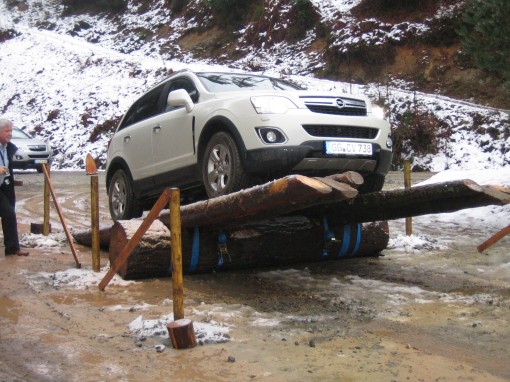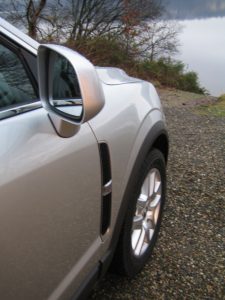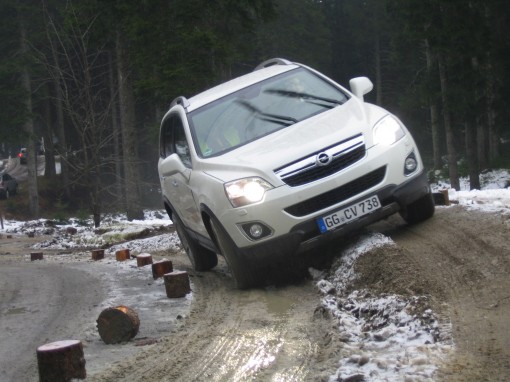Vauxhall’s Antara takes it all in its stride
Big on value Vauxhall’s facelifted Antara offers lots of space, refined new engines, and an impressive ride. Editor DAVID HOOPER put the new models to the test on challenging Scottish roads as part of the European launch.
VAUXHALL has given its Antara range a substantial makeover and has big ambitions for its smart-looking SUV.
I let the train take the strain for a change, to join a large group of British journalists on the updated model’s European launch in Scotland, where we were met, somewhat unusually, by left-hand drive German registered Opel-badged cars. It certainly made you think what you were doing, and driving in the gutter was the only way to stop your passenger from looking slightly nervous as a large coach, or lorry, appeared around the bend on fairly narrow Scottish roads in the beautiful Loch Lomond area, where snow still coated the tops of the mountains.
The UK’s PR director said that Vauxhall had had a successful year and that Britain is the fourth biggest market for General Motors. In Scotland, Vauxhall sells more cars than anyone else beating its main rival, Ford, into second place. So far, 80,000 Astras have been sold, while the Insignia and Zafira both lead the respective market sectors.
The Antara first went on sale in 2007, but up to now only around 1,000 of them have been sold every year. The SUV market however, has seen rapid growth in recent times, with the 4×4 suddenly back in fashion after the harsh winter we endured when only those with 4x4s managed to get to work , or deliver the children to school, so this facelifted model is expected to find some new fans and hit the 3,000 sales a year mark. It may sound like a tall order, but when you realise that one in 10 cars sold in this country are now SUVs, it begins to put things into perspective.
Buying an SUV is a lifestyle choice. People like the practicality the car offers, and the high driving position, as well as the rugged looks of a 4×4, but don’t always feel the need for four-wheel-drive, so the new Antara is available with just front wheel drive for those who prefer it that way. The 2WD versions are expected to account for 30-35% of sales, primarily in the retail sector.
There is a simple choice of just one 2.2-litre Euro 5 compliant engine in the UK, with two power outputs, one offering 163PS with two or four-wheel-drive, the other 184PS (4WD only), attached to either a 6-speed manual or a 6-speed automatic gearbox, both of which are also new. There will be no petrol option in the Britain, although a petrol engine will be offered in other markets.
I think that, externally, the car looks very good with its new chrome grille and high centre crease line which has become a Vauxhall design theme recently. Higher model grades gets chrome trimmings to add a bit of bling, and the rear light clusters have also been changed. Depending on your choice of model, there are 16, 17 and 18in alloy wheels, the latter being a new design, which is certainly eye-catching.
I was a bit disappointed with the interior, which has retained the previous generation of Vauxhall radio console and sat-nav system, instead of adopting the latest Vauxhall units used in the Insignia and Astra models, but the cost of changing all that would have been high, but it is familiar to Vauxhall fans, who will also welcome the fact that the car is very competitively priced.
The range starts from £19,995 on the road, undercutting its Ford Kuga rival by around £4,000, so if you can put up with a slightly dated interior there are substantial cash savings to be made. The Antara is also a larger car and feels much roomier inside. You do get an electric parking brake, which frees up space on the centre console for cup holders, and electric seats are also standard across the range and come with three heat settings.
The 2.2-litre engine is completely new and I have to say I was impressed. They provide strong performance and decent economy and C02 emissions figures, and pull strongly in the mid-range, where you need plenty of power. The gear change is a little on the lumpy side, particularly going from first to second, but once on the move, the car is fine, and it could have felt different driving on the left side of the car and changing gear with your left hand.
A lot of work has also been done to the car’s ride and handling which soon becomes evident from the driver’s seat. It’s a comfortable ride, and on some testing Scottish roads with badly broken surfaces, the car behaved very well. There is very little body roll, and when pressing on, I was impressed with the car’s ride quality and refinement – it’s very quiet inside, even with the diesel engine working quite hard.
While it’s never going to be a Land Rover, it can happily tackle forest tracks and moderately challenge obstacles, including a see-saw ramp and some fairly sharp angles. The AWD system on the top model is electronically controlled, and can transfer up to 50 per cent of the torque from the front wheels to the rear. A hill descent control system is also included in the car’s inventory.
It also has a wading depth of 45cm and has 17.6cm ground clearance.
With space for five, a good sized boot and very competitive pricing, the new Antara has a lot to commend it. It will be interesting to see if Vauxhall can reach the sales figures it is hoping for.



